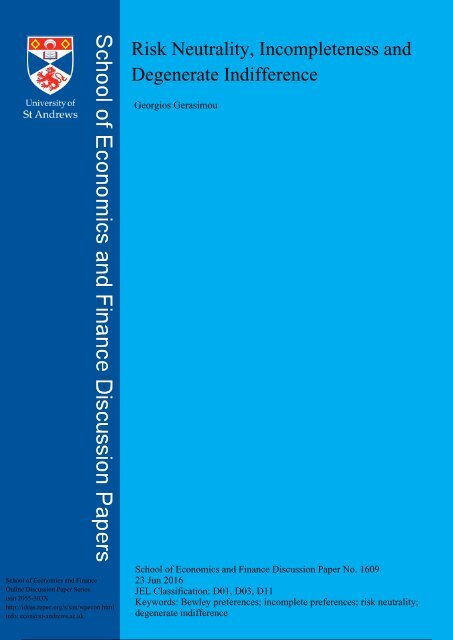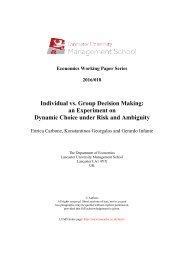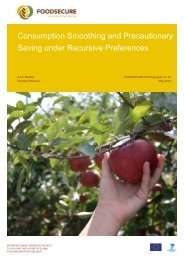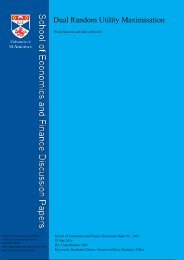Risk Neutrality Incompleteness and Degenerate Indifference
n?u=RePEc:san:wpecon:1609&r=upt
n?u=RePEc:san:wpecon:1609&r=upt
Create successful ePaper yourself
Turn your PDF publications into a flip-book with our unique Google optimized e-Paper software.
<strong>Risk</strong> <strong>Neutrality</strong>, <strong>Incompleteness</strong> <strong>and</strong><br />
<strong>Degenerate</strong> <strong>Indifference</strong><br />
Georgios Gerasimou<br />
School of Economics <strong>and</strong> Finance<br />
Online Discussion Paper Series<br />
issn 2055-303X<br />
http://ideas.repec.org/s/san/wpecon.html<br />
info: econ@st-<strong>and</strong>rews.ac.uk<br />
School of Economics <strong>and</strong> Finance Discussion Paper No. 1609<br />
23 Jun 2016<br />
JEL Classification: D01, D03, D11<br />
Keywords: Bewley preferences; incomplete preferences; risk neutrality;<br />
degenerate indifference
<strong>Risk</strong> <strong>Neutrality</strong>, <strong>Incompleteness</strong> <strong>and</strong> <strong>Degenerate</strong><br />
<strong>Indifference</strong><br />
Georgios Gerasimou ∗†<br />
June 23, 2016<br />
Abstract<br />
We show that strictly monotonic <strong>and</strong> risk-neutral Bewley preferences on the set of<br />
purely uncertain monetary acts over a finite state space are associated with a degenerate<br />
indifference relation. This conclusion is valid irrespective of whether strict or weak<br />
preferences are taken as primitive. In the latter case, it follows from this result that such<br />
a decision maker is indifferent between distinct acts only if her preferences are complete.<br />
Keywords: Bewley preferences; incomplete preferences; risk neutrality; degenerate indifference.<br />
JEL Classification: D01, D03, D11<br />
∗ School of Economics & Finance, University of St Andrews. Email: gg26@st-<strong>and</strong>rews.ac.uk<br />
† I thank Igor Rivin for a useful suggestion.
1 Introduction<br />
In Bewley’s (2002) model of preferences over monetary acts the primitive is an incomplete strict<br />
preference relation that is represented by a set of priors over the states of the world together<br />
with the decision rule whereby one act is preferred to another if <strong>and</strong> only if its expected value is<br />
strictly higher under every prior in that set. Rigotti <strong>and</strong> Shannon (2005), Kajii <strong>and</strong> Ui (2009)<br />
<strong>and</strong> Ma (2015) are papers in general equilibrium theory under Knightian uncertainty where agents<br />
are assumed to have Bewley preferences that may be of this type, 1 while Lopomo, Rigotti, <strong>and</strong><br />
Shannon (2011) <strong>and</strong> Chiesa, Micali, <strong>and</strong> Zhu (2015) are papers in contract theory <strong>and</strong> mechanism<br />
design, respectively, where risk-neutral Bewley preferences are assumed directly.<br />
Following Ghirardato, Maccheroni, Marinacci, <strong>and</strong> Siniscalchi (2003) <strong>and</strong> Gilboa, Maccheroni,<br />
Marinacci, <strong>and</strong> Schmeidler (2010), an alternative approach to modelling preferences over general<br />
Savage (1954) or Anscombe-Aumann (1963) acts that are defined by Bewley’s unanimity rule is<br />
to take a possibly incomplete weak preference relation as the primitive, <strong>and</strong> let it be determined<br />
by weak rather than strict dominance with respect to every prior. Each of these approaches is<br />
associated with certain advantages <strong>and</strong> disadvantages, briefly reviewed below.<br />
A thing in common for these two approaches that is important for the purposes of this note<br />
is that the agent is assumed to be indifferent between two acts if <strong>and</strong> only if their expected<br />
value/expected utility is the same under every prior. We show, in particular, that when risk-neutral<br />
Bewley preferences of either type are defined on the linear space of purely uncertain monetary acts<br />
over a finite state space, <strong>and</strong> also satisfy strict monotonicity (as in Bewley’s (2002) Theorem 1, for<br />
instance), then the indifference relation associated with them is degenerate: there exist no distinct<br />
acts between which the decision maker is indifferent. An important implication of this result in<br />
the case where weak preferences are primitive is that strict monotonicity is incompatible with<br />
indifference non-triviality unless preferences are complete.<br />
2 <strong>Degenerate</strong> <strong>Indifference</strong>: A Sufficient Condition<br />
The choice domain is the set of all acts f : S → R, where S = {1, . . . , n} is the finite state space.<br />
This domain coincides with R n <strong>and</strong> will be denoted by X. We will write 0 for the zero vector in<br />
X. Moreover, for i ≤ n, we let e i st<strong>and</strong> for the element of X whose i-th coordinate is 1 <strong>and</strong> all<br />
other coordinates are zero. For x, y ∈ X, we write x ≥ y whenever x i ≥ y i for all i ≤ n.<br />
The set of all probability measures on S is denoted by ∆(S). As in Rigotti <strong>and</strong> Shannon<br />
(2005), for P ⊆ ∆(S) we define the interior of P relative to the set {x ∈ R n : ∑ n<br />
i=1 x i = 1}<br />
by rint(P ) = {p ∈ ∆(S) : p i > 0 for all i ≤ n} if P = ∆(S), <strong>and</strong> rint(P ) = {p ∈ ∆(S) :<br />
B ɛ (p) ∩ rint(∆(S)) ⊂ P for some ɛ > 0} if P ⊂ ∆(S), where B ɛ (p) is the Euclidean open ball<br />
around p. When we make a reference to a set P ⊆ ∆(S) we will use the terms interior <strong>and</strong> relative<br />
interior interchangeably.<br />
The following result is key in what follows.<br />
Proposition 1.<br />
Let ∼ be an equivalence relation on X <strong>and</strong> P ⊆ ∆(S) a compact, convex set with nonempty interior<br />
such that<br />
x ∼ y ⇐⇒ px = py for all p ∈ P (1)<br />
1 Kajii <strong>and</strong> Ui (2009), in particular, showed that when all agents’ Bewley preferences are risk-neutral, an allocation is interim efficient<br />
if <strong>and</strong> only if there exists a common element in the agents’ sets of priors.<br />
1
Then,<br />
x ∼ y ⇐⇒ x = y (2)<br />
The proof appears in the Appendix. In the case where n = 2 this result can be easily illustrated<br />
with an example: Suppose x ∼ y for x, y ∈ R 2 . It follows from (1) <strong>and</strong> the nonempty-interior<br />
assumption that there exist distinct probability measures (p, 1 − p) <strong>and</strong> (q, 1 − q) in P such that<br />
px 1 + (1 − p)x 2 = py 1 + (1 − p)y 2<br />
qx 1 + (1 − q)x 2 = qy 1 + (1 − q)y 2<br />
Moreover, since P has a nonempty interior, (p, 1 − p) <strong>and</strong> (q, 1 − q) can be chosen to be strictly<br />
positive. In this case, dividing the first equation by p <strong>and</strong> the second by q, <strong>and</strong> then subtracting<br />
the former from the latter yields x 2 = y 2 <strong>and</strong> x 1 = y 1 . The proof of the general case generalizes this<br />
argument mainly by showing that there exists an n-tuple of strictly positive probability measures<br />
that span X ≡ R n .<br />
3 Strict Bewley Preferences<br />
As in Bewley (2002), we first explore the implications of Proposition 1 in the case where the primitive<br />
is a strict preference relation ≻ on X. The following four axioms are st<strong>and</strong>ard in this context<br />
<strong>and</strong> were also employed in the statement of Bewley’s Theorem 1, which is of direct relevance here.<br />
Strict Partial Order<br />
≻ is asymmetric <strong>and</strong> transitive.<br />
Independence<br />
For all x, y, z ∈ X <strong>and</strong> all α ∈ (0, 1), x ≻ y implies αx + (1 − α)z ≻ αy + (1 − α)z.<br />
Strict Monotonicity<br />
For all x, y ∈ X, x ≥ y <strong>and</strong> x ≠ y implies x ≻ y.<br />
Upper Hemicontinuity<br />
For all x ∈ X, the set U ≻ (x) := {y ∈ X : y ≻ x} is open.<br />
We restate Bewley’s Theorem 1 below in a way that reflects the indifference-degeneracy implications<br />
of Proposition 1 <strong>and</strong> also allows for one additional clarification to be made.<br />
Corollary 2.<br />
A binary relation ≻ on X is a Strict Partial Order that satisfies Independence, Strict Monotonicity<br />
<strong>and</strong> Upper Hemicontinuity if <strong>and</strong> only if there exists a compact, convex set P ⊆ rint(∆(S)) such<br />
that, for all x, y ∈ X,<br />
x ≻ y ⇐⇒ px > py for all p ∈ P (3)<br />
x = y ⇐⇒ px = py for all p ∈ P (4)<br />
Although Bewley (2002) did not assume an indifference relation as part of the model’s primitives,<br />
he noted that once a set of priors P that represents ≻ in the sense of (3) is known to exist, an<br />
2
indifference relation ∼ on X could be defined by x ∼ y ⇔ px = py for all p ∈ P . Driven by<br />
Proposition 1, part (4) of this result clarifies that, under the conditions assumed in Bewley’s<br />
(2002) Theorem 1, this indifference relation is actually degenerate. Moreover, the statement of<br />
Corollary 2 also clarifies that the relevant conditions in Bewley’s (2002) Theorem 1 are not merely<br />
sufficient but also necessary for ≻ to be represented as in (3).<br />
We note, finally, that when a strict relation ≻ is assumed to be the primitive in a model of<br />
incomplete preferences, Galaabaatar <strong>and</strong> Karni (2013) suggested to define an indifference relation<br />
∼ from ≻ by letting x ∼ y if <strong>and</strong> only if U ≻ (x) = U ≻ (y). 2 Since this ∼ is an equivalence relation,<br />
it follows from Proposition 1 that this too is degenerate in the present context whenever the set<br />
P that represents ≻ has a nonempty interior.<br />
4 Weak Bewley Preferences<br />
A conceptual difficulty with the strict-preference version of Bewley’s unanimity model is that it<br />
does not specify a relevant “mild preference” label for the cases where all priors weakly favour an act<br />
x over another act y <strong>and</strong> some but not all strictly favour x. An approach that addresses this issue<br />
was followed by Ghirardato, Maccheroni, Marinacci, <strong>and</strong> Siniscalchi (2003), Gilboa, Maccheroni,<br />
Marinacci, <strong>and</strong> Schmeidler (2010) <strong>and</strong> Ok, Ortoleva, <strong>and</strong> Riella (2012), who took as the primitive<br />
a (possibly incomplete) weak preference relation . Unlike Bewley’s (2002) framework, under this<br />
approach the relations ≻ <strong>and</strong> ∼ that define strict preference <strong>and</strong> indifference are derived from <br />
as its asymmetric <strong>and</strong> symmetric parts in the usual way. While this is an advantage of the weakover<br />
the strict-preference approach, a well-known difficulty that arises here is that even though<br />
the relation is continuous, its strict part ≻ cannot be unless is complete (see below).<br />
To study the analogue of Corollary 2 in a weak-preference framework we state a few axioms<br />
that are particular to such a relation.<br />
Preorder<br />
is reflexive <strong>and</strong> transitive.<br />
<strong>Incompleteness</strong><br />
There exist x, y ∈ X such that x ̸ y <strong>and</strong> y ̸ x.<br />
Restricted Hemicontinuity<br />
The set U (0) := {y ∈ X : y 0} is closed.<br />
The former two axioms ensure that is a transitive <strong>and</strong> incomplete weak preference relation.<br />
It will be clear in the statement of the result below why requiring incompleteness explicitly is<br />
important for our purposes. Although the third axiom is weaker, in principle, than the st<strong>and</strong>ard<br />
axiom of closed-graph continuity, it turns out that in the present context the two are equivalent. 3<br />
As far as the Independence axiom for is concerned, it coincides with the one that was stated in<br />
the previous section provided that ≻ is replaced by .<br />
2 Bewley (2002) called two acts x <strong>and</strong> y equivalent when, in addition, to the above condition of Galaabaatar <strong>and</strong> Karni (2013) that<br />
requires equality between the strict upper contour sets of x <strong>and</strong> y, their strict lower contour sets are also equal.<br />
3 The reader is referred to Theorem 1 in Gerasimou (2015) <strong>and</strong> p. 156 in Ghirardato, Maccheroni, <strong>and</strong> Marinacci (2004) for more<br />
details on this.<br />
3
Corollary 3.<br />
A binary relation on a X is a Preorder that satisfies <strong>Incompleteness</strong>, Independence, Strict<br />
Monotonicity <strong>and</strong> Restricted Hemicontinuity if <strong>and</strong> only if there exists a compact, convex set P ⊆<br />
∆(S) with nonempty interior such that, for all x, y ∈ X<br />
x y ⇐⇒ px ≥ py for all p ∈ P (5)<br />
x = y ⇐⇒ px = py for all p ∈ P (6)<br />
Moreover,<br />
(x y ⇔ x ≥ y) ⇐⇒ P = ∆(S) (7)<br />
It is an implication of Proposition A.1 in Ghirardato, Maccheroni, <strong>and</strong> Marinacci (2004) that<br />
the stated axioms are sufficient for the existence of a set P ⊆ ∆(S) that represents as in (5).<br />
It is easy to verify that Strict Monotonicity implies a nonempty interior for P . In light of this<br />
fact, the indifference-degeneracy implication (6) again follows from Proposition 1. Given (6), it is<br />
easily seen that (7) is true. This equivalence shows that, in the present setting, Bewley preferences<br />
coincide with the usual partial ordering if <strong>and</strong> only if P contains all possible priors, hence that the<br />
model becomes uninformative in this special case.<br />
Importantly, Corollary 3 can also be stated as a preference-completion theorem. To this end,<br />
we write explicitly as an axiom the requirement that there exist two distinct acts between which<br />
the decision maker is indifferent.<br />
Nontrivial <strong>Indifference</strong><br />
There exist distinct x, y ∈ X such that x ∼ y.<br />
Corollary 4.<br />
If is a Preorder on X that satisfies Independence, Strict Monotonicity, Nontrivial <strong>Indifference</strong><br />
<strong>and</strong> Restricted Hemicontinuity, then is complete.<br />
This result parallels the well-known <strong>and</strong> general preference-completion theorem that is due to<br />
Schmeidler (1971). The latter provides natural topological conditions on the preference domain<br />
(i.e. connectedness) as well on the relation <strong>and</strong> its asymmetric part ≻ (i.e. hemicontinuity)<br />
that are sufficient for to be complete. Although the domain in Corollary 4 is a special case in<br />
the class of domains that Schmeidler’s theorem allows for, we note that, unlike the latter result,<br />
almost every condition in the statement of Corollary 4 is a preference postulate with a behavioral<br />
content.<br />
Appendix<br />
Proof of Proposition 1.<br />
We will first show that there is a set {q 1 , . . . , q n } of n linearly independent elements in rint(P ).<br />
Let p ∈ rint(P ). For ɛ > 0, let B ɛ (p) := {v ∈ R n ++ : d(v, p) < ɛ}, where d denotes Euclidean<br />
distance. For all i ≤ n, define q i ∈ R n ++ by<br />
q i := p + ɛ 2 ei .<br />
4
Observe that the set {q 1 , . . . , q n } ⊂ R n ++ consists of n linearly independent vectors. Hence, it is a<br />
basis of R n . Now define q i by<br />
q i :=<br />
q i<br />
||q i || 1<br />
where ||q i || 1 := ∑ n<br />
j=1 qj i . Observe also that, for all i, j ≤ n, ||q i|| 1 = ||q j || 1 = 1 + ɛ 2 . Define<br />
β := 1<br />
1 + ɛ .<br />
2<br />
Notice that since {q 1 , . . . , q n } is a basis of R n <strong>and</strong> q i ≡ βq i for all i ≤ n, the set {q 1 , . . . , q n } is also<br />
a basis of R n . Moreover, by construction, q i ∈ B ɛ (p). Since p ∈ rint(P ), choosing ɛ > 0 sufficiently<br />
small ensures that q i ∈ rint(P ) for all i ≤ n.<br />
Now consider x, y ∈ X <strong>and</strong> suppose x ∼ y. Let z := x − y. To establish (2) it suffices to show<br />
that if pz = 0 for all p ∈ P , then z = 0. To this end, suppose pz = 0 for all p ∈ P . It holds that<br />
( n∑<br />
i=1<br />
q i z = 0, for all i = 1, . . . , n (8)<br />
n∑<br />
λ i q i ≠ 0, for all (λ 1 , . . . , λ n ) ∈ R n \ {0} (9)<br />
i=1<br />
λ i q i<br />
)<br />
z = 0, for all (λ 1 , . . . , λ n ) ∈ R n \ {0} (10)<br />
where (8) is true by assumption, (9) follows from the fact that {q 1 , . . . , q n } is a basis of R n , <strong>and</strong><br />
(10) is implied by (8). In particular, it follows from (9) <strong>and</strong> (10) that z = 0, which is equivalent<br />
to x = y.<br />
<br />
References<br />
Anscombe, F. J., <strong>and</strong> R. J. Aumann (1963): “A Definition of Subjective Probability,” Annals<br />
of Mathematical Statistics, 14, 477–482.<br />
Bewley, T. F. (2002): “Knightian Decision Theory. Part I,” Decisions in Economics <strong>and</strong> Finance,<br />
25, 79–110.<br />
Chiesa, A., S. Micali, <strong>and</strong> Z. A. Zhu (2015): “Knightian Analysis of the Vickrey Mechanism,”<br />
Econometrica, 83, 1727–1754.<br />
Galaabaatar, T., <strong>and</strong> E. Karni (2013): “Subjective Expected Utility with Incomplete Preferences,”<br />
Econometrica, 81, 255–284.<br />
Gerasimou, G. (2015): “(Hemi)Continuity of Additive Preference Preorders,” Journal of Mathematical<br />
Economics, 58, 79–81.<br />
Ghirardato, P., F. Maccheroni, <strong>and</strong> M. Marinacci (2004): “Differentiating Ambiguity<br />
<strong>and</strong> Ambiguity Attitude,” Journal of Economic Theory, 118, 133–173.<br />
Ghirardato, P., F. Maccheroni, M. Marinacci, <strong>and</strong> M. Siniscalchi (2003): “A Subjective<br />
Spin on Roulette Wheels,” Econometrica, 71, 1897–1908.<br />
5
Powered by TCPDF (www.tcpdf.org)<br />
Gilboa, I., F. Maccheroni, M. Marinacci, <strong>and</strong> D. Schmeidler (2010): “Objective <strong>and</strong><br />
Subjective Rationality in a Multiple Prior Model,” Econometrica, 78, 755–770.<br />
Kajii, A., <strong>and</strong> T. Ui (2009): “Interim Efficient Allocations Under Uncertainty,” Journal of<br />
Economic Theory, 144, 337–353.<br />
Lopomo, G., L. Rigotti, <strong>and</strong> C. Shannon (2011): “Knightian Uncertainty <strong>and</strong> Moral Hazard,”<br />
Journal of Economic Theory, 146, 1148–1172.<br />
Ma, W. (2015): “The Existence <strong>and</strong> Efficiency of General Equilibrium with Incomplete Markets<br />
under Knightian Uncertainty,” Economics Letters, 134, 78–81.<br />
Ok, E., P. Ortoleva, <strong>and</strong> G. Riella (2012): “Incomplete Preferences under Uncertainty:<br />
Indecisiveness in Beliefs Versus Tastes,” Econometrica, 80, 1791–1808.<br />
Rigotti, L., <strong>and</strong> C. Shannon (2005): “Uncertainty <strong>and</strong> <strong>Risk</strong> in Financial Markets,” Econometrica,<br />
73, 203–243.<br />
Savage, L. J. (1954): The Foundations of Statistics. New York: Wiley.<br />
Schmeidler, D. (1971): “A Condition for the Completeness of Partial Preference Relations,”<br />
Econometrica, 39, 403–404.<br />
6






